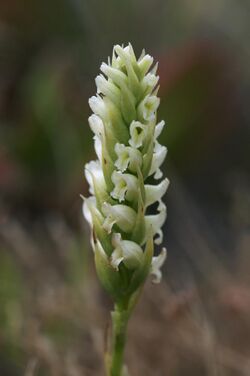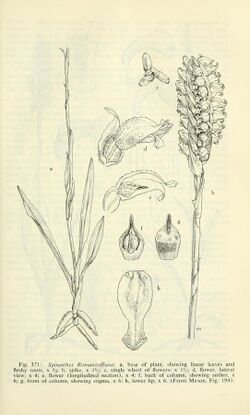Biology:Spiranthes romanzoffiana
| Spiranthes romanzoffiana | |
|---|---|

| |
| Scientific classification | |
| Kingdom: | Plantae |
| Clade: | Tracheophytes |
| Clade: | Angiosperms |
| Clade: | Monocots |
| Order: | Asparagales |
| Family: | Orchidaceae |
| Subfamily: | Orchidoideae |
| Tribe: | Cranichideae |
| Genus: | Spiranthes |
| Species: | S. romanzoffiana
|
| Binomial name | |
| Spiranthes romanzoffiana Cham.
| |
| Synonyms | |
| |
Spiranthes romanzoffiana, commonly known as hooded lady's tresses[1] (alternatively hooded ladies' tresses[2]) or Irish lady's-tresses[3] (Irish: Cùilìn Gaelach), is a species of orchid. Collected by Chamisso during the Romanzov expedition it was described by him in 1828 and named for Count Nikolay Rumyantsev who financed the expedition. This orchid is native to North America, Ireland and the British Isles.[4]

Description
Hooded lady's tresses is a perennial plant with a fleshy rootstock. It sends up shoots with lanceolate leaves and three rows of flowers arranged in spirally twisted rows. Each scented flower has the sepals and petals united forming a lip of a tube. The labellum (or lower petal) of the flower is white with green veins.[5][6]
The plant flowers in late summer. The flowers are pollinated by insects, and the tiny dust-like seed is distributed by the wind. However the plant can also reproduce vegetatively by means of root tubers which can grow new shoots while the old parts of the plant die. The orchid is associated with a mycorrhizal fungus which can provide it with essential nutrients.[6]
Distribution and habitat
Hooded ladies' tresses was first described by the German botanist Adelbert von Chamisso. He named it in honour of his patron Nikolay Rumyantsev who had financed the scientific exploration to the Americas in 1815–1818 on which he found the orchid. It is common in North America, including Canada and the United States, but also grows in a few locations in Scotland and Ireland.[2] It is now considered regionally extinct in England, but has recently (2019) been found in Wales.[7] The first Irish record was made in 1810 in County Cork.[8] Since then it has been found in a number of other locations in Ireland and Northern Ireland, including the Lough Neagh basin and the Mourne Mountains and the hills of Antrim.[6] It grows along lakeshores and in damp pastures.[5] The distribution pattern, occurring on both sides of the Atlantic Ocean, is puzzling.[9]
Ecology
Interactions between Irish Lady's Tresses and Its pollinating partners have only been studied in the West Irish populations.[10] The most common pollinators are the Bombus pascuorum, B. hortorum and Apis mellifera.[10] Studies on Mycorrhizal associations for Irish Lady's Tresses have not been conducted. Recent studies have found genetic hybrids in the Ontario, Canada population.[11] Genetic studies have also been conducted in order to ascertain the genetic adversity of the European Population.[12]
References
- ↑ "Spiranthes romanzoffiana". Natural Resources Conservation Service PLANTS Database. USDA. https://plants.usda.gov/core/profile?symbol=SPRO.
- ↑ 2.0 2.1 "Spiranthes romanzoffiana (Hooded Ladies' Tresses)". Go Orchids. https://goorchids.northamericanorchidcenter.org/species/spiranthes/romanzoffiana/.
- ↑ (xls) BSBI List 2007, Botanical Society of Britain and Ireland, https://bsbi.org/download/3542/, retrieved 2014-10-17
- ↑ "World Checklist of Selected Plant Families". http://apps.kew.org/wcsp/namedetail.do?name_id=194494.
- ↑ 5.0 5.1 Parnell, J. and Curtis, T. 2012. Webb's An Irish Flora. Cork University Press. ISBN:978-185918-4783
- ↑ 6.0 6.1 6.2 "Spiranthes romanzoffiana – Irish lady's-tresses". Northern Ireland Priority Species. http://www.habitas.org.uk/priority/species.asp?item=2298.
- ↑ "GB Red list for vascular plants (revised 2019)". Botanical Society of Britain & Ireland. 2021. https://bsbi.org/download/17380/.
- ↑ Hackney,P. Ed. 1992. Stewart & Corry's Flora of the North-east of Ireland. Third edition. Institute of Irish Studies, The Queen's University of Belfast ISBN:0-85389-446-9
- ↑ Dunn, Jon (2018). Orchid Summer: In Search of the Wildest Flowers of the British Isles. Bloomsbury Publishing. pp. 389–392. ISBN 978-1-4088-8090-6. https://books.google.com/books?id=Jhc0DwAAQBAJ&pg=PT389.
- ↑ 10.0 10.1 Duffy, Karl (January 2008). "The Effects of Plant Density and Nectar Reward on Bee Visitation to the Endangered Orchid Spiranthes Romanzoffiana.". Acta Oecologica 34 (2): 131–138. https://www.sciencedirect.com/science/article/pii/S1146609X08000805.
- ↑ R. C, Simpson (January 1978). "Spiranthes Lacera Var. Lacera X S. Romanzoffiana, a New Natural Hybrid Orchid from Ontario.". Canadian Field-Naturalist 1 (1): 350–358.
- ↑ Hollingsworth, Peter (December 2003). "Population Genetic Structure in European Populations of Spiranthes Romanzoffiana Set in the Context of Other Genetic Studies on Orchids". Heredity 92: 218–227. https://www.nature.com/articles/6800399.
- Correll, D.S., Native Orchids of North America, p. 220. 1978.
Further references
- Smith, J. E. August 1834. English Botany, Supplement 2786. Copied to New Edition (1840), Volume 7, Page 13, Plate 1212**. "Neottia gemmipara, Proliferous Lady's Tresses"
- Horsman, F. 2013. The discovery and subsequent history of Spiranthes romanzoffiana Chamisso (Orchidaceae) at Castletown Bearhaven in West Cork (H3) Irish Naturalists' Journal 32 19 - 25.
External links
Wikidata ☰ Q520460 entry
 |

